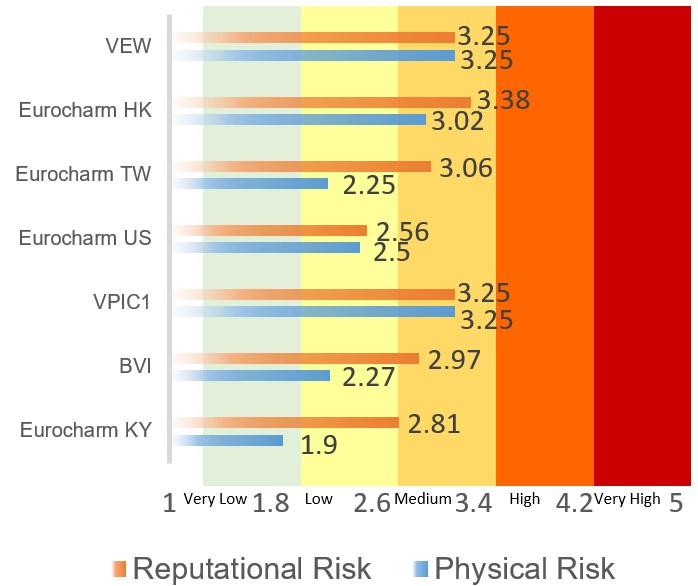Eurocharm‘s main production sites are located in Taiwan and Vietnam. All selected production bases are situated within industrial zones approved by the local government, with no protected habitats or areas of high biodiversity significance to indigenous peoples or local communities. However, the company remains committed to ecological conservation. The Vietnam facility, which has a larger land area, incorporates appropriate vegetation to green the environment and mitigate environmental impact. Eurocharm refers to the Biodiversity Risk Filter, a biodiversity risk assessment tool developed by the World Wide Fund for Nature (WWF), to evaluate the potential impact and dependence risks of its business activities on biodiversity. The assessment covers seven operational sites, including Eurocharm Holdings, B.V.I., Vietnam VPIC1, Eurocharm US, Eurocharm TW, Eurocharm HK, and VEW. The results indicate that all locations fall within the medium to low-medium biodiversity risk category.

Our company manufactures automotive parts using 100% metal materials such as steel and aluminum. All steel scrap is fully recycled, while aluminum offcuts can be remelted and recast into aluminum components.
During the execution of the Baishan new plant project, we also prioritized ecological protection in the factory’s location to minimize environmental impact, conducting environmental assessments for various factory emissions.
Eurocharm’s “Biodiversity and No Deforestation Commitment”:
Eurocharm fully recognizes the importance of biodiversity and no deforestation for ecological and climate stability. Therefore, we are committed to maintaining and promoting biodiversity in our operations, avoiding all forms of deforestation, and further advancing forest restoration. This aligns with the United Nations Sustainable Development Goals (SDGs) 6, 12, 13, 14, and 15, as well as the Post-2020 Global Biodiversity Framework, to achieve the 2030 milestone of “halting biodiversity loss” and the 2050 vision of “living in harmony with nature.”。
Biodiversity and No Deforestation Commitment
- The principle is to avoid engaging in new operational activities (including new factories) in areas adjacent to critical biodiversity regions. However, if it is necessary for national infrastructure projects, factories built near critical biodiversity areas will also adhere to relevant national regulations for environmental impact assessments. This includes assessing and monitoring the risks to biodiversity and forest damage, and formulating mitigation strategies, including prevention, reduction, restoration, and compensation measures, to protect the ecosystem in these critical areas and ensure the goal of No Net Loss is achieved.
- Existing operational activities located in areas adjacent to critical biodiversity regions will gradually conduct risk assessments and monitoring on the use of natural resources and biodiversity. This will help plan responses and reduce reliance on and negative impacts on natural resources. Efforts will be made to achieve a Net Positive Impact on biodiversity in the affected areas by 2030.
- Inventory the current usage of timber products (such as packaging materials) in operational activities and allocate resources for forest restoration, aiming to gradually achieve the goal of No Net Deforestation by 2030.
- Continuously enhance stakeholders’ (employees, customers, suppliers) awareness of the importance of biodiversity and forest conservation.
- Participate in key domestic and international biodiversity initiatives to stay informed about the development of biodiversity issues and plan long-term strategies.
- Regularly disclose progress on biodiversity and deforestation-free initiatives on the official website or in sustainability reports.
Biodiversity mitigation actions
To reduce the dependency on and impact on biodiversity, our company has implemented the following mitigation measures and action plans, as outlined in the table below:
| Mitigation Measures | Eurocharm Actions |
|---|---|
| Avoid | ● New factories should be avoided in protected areas. |
| Reduce | ● Proactively schedule annual maintenance for production equipment to avoid deterioration of air quality. ● Strive to promote the recycling of aluminum scrap to reduce the environmental burden caused by process-generated waste. |
| Regenerate | ● The VPIC1 factory in Vietnam has a large area, and appropriate plants will be planted within the site to green the environment and reduce its impact on the surroundings. ● Create a suitable habitat for wildlife by planting butterfly- and bird-attracting plants. |
| Restore | ● Evaluate the adoption of plant maintenance and care for local parks in Vietnam. |
| Transform | ● Organize a green plant creativity competition to encourage employees to co-create a low-carbon, green lifestyle. |



